|
|
|
Sort Order |
|
|
|
Items / Page
|
|
|
|
|
|
|
| Srl | Item |
| 1 |
ID:
103187
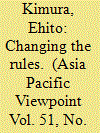

|
|
|
|
|
| Publication |
2010.
|
| Summary/Abstract |
After more than three decades of military authoritarian rule, President Suharto resigned from office in May of 1998 and peacefully handed power over to his vice-president, B.J. Habibie. The ensuing period of transition can be characterised as a 'critical historical conjuncture', in that agents wielded a unusually large set of choices about the direction to take the country. This article explores this period, and examines both the roots of the historical conjuncture and its outcomes. It argues that long-term factors laid the foundations for change, but short-term factors shaped the timing and way the New Order would fall. It also argues that current outcomes attributable to the historical conjuncture include territorial resilience, a competitive electoral system, and paradoxically, elite entrenchment.
|
|
|
|
|
|
|
|
|
|
|
|
|
|
|
|
| 2 |
ID:
089924
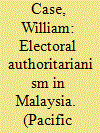

|
|
|
|
|
| Publication |
2009.
|
| Summary/Abstract |
This paper proposes an analytical framework by which to understand the origins, functioning, and dynamics of electoral authoritarianism in Malaysia. It thus explores notions of historical legacies, structural pressures, critical junctures, and institutional formation. But in guarding against teleology, it also considers elite agency and 'stunning elections'. This framework is applied in the case of Malaysia because, in anticipating contemporary trends, the country has so long perpetuated a paradigmatic electoral authoritarian regime. And yet, with many countries growing similarly authoritarian today, Malaysia has suddenly become less so, with the government having been dealt a startling setback in its latest contest, held in March 2008, thus losing its extraordinary majority in parliament and control over five states. Hence, if democratization once again gains steam round the world, Malaysia may presage this trend too, with its electoral authoritarianism, long so resilient, perhaps poised today on the edge of transition.
|
|
|
|
|
|
|
|
|
|
|
|
|
|
|
|
| 3 |
ID:
171774
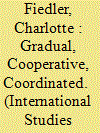

|
|
|
|
|
| Summary/Abstract |
This article analyzes the success factors for external engagement aimed at fostering peace in conflict-affected states. It focuses on a set of three factors that have been under-researched so far: the strategic prioritization between stability and democracy, the degree of coordination, and the mode of interaction. We compare international engagement in six countries—Burundi, Kenya, Kyrgyzstan, Nepal, Senegal, and Timor-Leste. These countries all struggled with violent conflict and experienced a democratic transition in the period 2000–2014. We use an innovative approach to assess the impact of external engagement by analyzing twenty critical junctures in the domestic political processes of these countries mainly linked to elections, constitution-writing processes, and peace agreements, as well as disarmament, demobilization, and reintegration. Based on over 300 interviews, we find that prioritizing stability over democratization is problematic, good international coordination has positive effects, and preferring cooperative forms of interaction over coercion is mostly but not always useful. In discussing these general features of international support, this article contributes to the broader discussion of factors that explain the impact external actors can have on transformative political processes after conflict.
|
|
|
|
|
|
|
|
|
|
|
|
|
|
|
|
| 4 |
ID:
173006
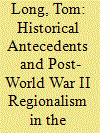

|
|
|
|
|
| Summary/Abstract |
After World War II, the US-led international security order exhibited substantial regional variation. Explaining this variation has been central to the debate over why is there no nato in Asia. But this debate overlooks the emergence of multilateral security arrangements between the United States and Latin American countries during the same critical juncture. These inter-American institutions are puzzling considering the three factors most commonly used to explain divergence between nato and Asia: burden-sharing, external threats, and collective identity. These conditions fail to explain contemporaneous emergence of inter-American security multilateralism. Although the postwar inter-American system has been characterized as the solidification of US dominance, at the time of its framing, Latin American leaders judged the inter-American system as their best bet for maintaining beneficial US involvement in the Western Hemisphere while reinforcing voice opportunities for weaker states and imposing institutional constraints on US unilateralism. Drawing on multinational archival research, the author advances a historical institutionalist account. Shared historical antecedents of regionalism shaped the range of choices for Latin American and US leaders regarding the desirability and nature of new regional institutions while facilitating institutional change through mechanisms of layering and conversion during this critical juncture.
|
|
|
|
|
|
|
|
|
|
|
|
|
|
|
|
| 5 |
ID:
181930
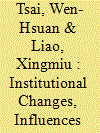

|
|
|
|
|
| Summary/Abstract |
The Chinese Communist Party (CCP) regards the Communist Youth League (CYL) as a critical and distinctive mass organization that acts as an “assistant” and “reserve army” for the Party. This article uses the analytical concepts of historical institutionalism and critical junctures to discuss the changes in the CYL during the post-Mao period. We focus on two critical junctures: 1982, when the CYL became a route to rapid promotion for cadres, and 2016, after which its cadres had fewer opportunities for promotion and the CYL was pushed back to its original role in youth United Front work. We also find that the CYL has refined its United Front methods to attract talented young people by offering them services. This reflects the efforts of the CCP regime to adapt to circumstances and ensure its survival.
|
|
|
|
|
|
|
|
|
|
|
|
|
|
|
|
| 6 |
ID:
184127
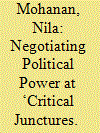

|
|
|
|
|
| Summary/Abstract |
From a feminist institutionalist perspective, this article engages in a comparative analysis of South Africa, one of the only post-transition democracies where women organized as a distinct interest group representing gender interests were able to negotiate and gain access to political power, and India, where women’s participation was predominantly as ‘nationalist women’. It argues that constitution drafting is a decisive critical juncture when descriptive representation can be translated very effectively into the substantive representation of women as equal citizens, provided women qua women and as gender-conscious agents are able to intervene to promote the cause of their effective political participation.
|
|
|
|
|
|
|
|
|
|
|
|
|
|
|
|
| 7 |
ID:
113873
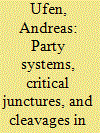

|
|
|
|
|
| Publication |
2012.
|
| Summary/Abstract |
This article differentiates between clientelist (Thailand and the Philippines) and cleavage-based parties and party systems (Malaysia and Indonesia) with reference to insights of historical institutionalism. Clientelist parties, in contrast to cleavage-based ones, often undermine democratization because, on average, representativeness is weak, bureaucracy is more politicized, and rent-seeking behavior is widespread.
|
|
|
|
|
|
|
|
|
|
|
|
|
|
|
|
| 8 |
ID:
147609
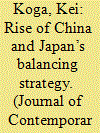

|
|
|
|
|
| Summary/Abstract |
This article argues that as opposed to the conventional wisdom of Japan’s hedging policy, Japan has been constantly taking balancing behavior vis-à-vis China since the end of the Cold War; however, the incremental shift to explicit balancing began after the 2010 Senkaku Boat Collision Incident. The shift was accelerated by the 2012 Japanese Government Purchase of the Senkaku Islands. Since then, Japan has attempted to engage in both internal and external balancing by taking more security burden-sharing with the United States through the relaxation of Japan’s constitutional and political constraints on its military capabilities and the enhancement of security linkages with other regional states, such as Australia and India.
|
|
|
|
|
|
|
|
|
|
|
|
|
|
|
|
| 9 |
ID:
181243


|
|
|
|
|
| Summary/Abstract |
Women’s rights are being enshrined in African constitutions today to an unprecedented extent. African countries have on average more constitutional provisions addressing women’s rights than any other region of the world. This longitudinal cross-national study shows that constitutional reforms in African contexts are increasingly evident in the areas of gender equality, customary law, discrimination, violence against women, gender quotas, and citizenship rights, and they sometimes reflect gender-inclusive language. By analysing a novel data set of constitutional reforms across all African countries over 68 years (1951–2019), this article identifies four critical junctures when the adoption of women’s rights reforms arose, namely (i) after independence, particularly in Muslim-majority countries; (ii) after political opening in the 1990s; (iii) after the end of major civil conflicts; and (iv) after the 2011 Arab uprisings. At each juncture, women’s movements capitalized on political openings to advance constitutional reforms that are unmatched on a global scale. This article goes beyond the existing explanations of cumulative gains, international influence, diffusion, learning, and borrowing to show that a ‘critical junctures’ approach may help explain when, why, and how women’s rights reforms occur in constitutions.
|
|
|
|
|
|
|
|
|
|
|
|
|
|
|
|
|
|
|
|
|